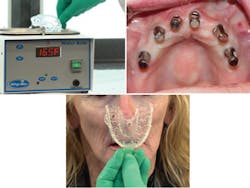IMMEDIATE IMPLANT PROSTHETICS AND PROVISIONAL LINERS GO HAND-IN-HAND
by Joseph J. Massad, DDS
Welcome back! This month I will address the use of viscoelastic (resilient) liners for use in implant therapy. As far back as I can remember, dentistry has suggested the use of viscoelastic liners for edentulous patients to allow tissues to replenish prior to making definitive impressions. The type of liners that have been recommended are generally temporary and chemically have a short lifespan before degrading and becoming hard. One of the problems with any temporary liner is that within a short period of time, depending on certain factors, they begin to take on odors and harden, thereby necessitating frequent replacement.
About 20 years ago, I began to track how long it took me to remove a temporary liner only to replace it with another temporary liner. The task to remove the temporary liner was very time consuming. On the average, most temporary liners will hold up for a few weeks, and this may not provide enough time for the tissues to replenish or for the prosthesis to be completed. These temporary viscoelastic liners may be conducive to biofilm accumulation. Biofilms can be defined as communities of microorganisms attached to a surface.
After researching many of the viscoelastic liners available, I found that the optimal liner has a powdered resin and liquid which, once mixed, will cure and bond to the standard acrylic prosthesis. The material I presently utilize is a two-component system consisting of a powder component of polyethylmethacrylate blended with a liquid component of di-n-butyl phthalate, ethyl acetate, and ethyl alcohol. It has been indicated for use in stabilizing and relining complete and partial dentures, cushioning sensitive tissues, and recently has been utilized in the implant overdenture (Permasoft, DENTSPLY Prosthetics). This material chemically bonds to most, if not all, prostheses made with methyl methacrylate once the surfaces have been cleaned and mechanically roughened.
Even though there are other materials that are in a more convenient auto-mix syringe, I have found the polyethylmethacrylate resilient liner chemistry performs as a long-term liner and does not need to be replaced often compared to temporary liners. These liners can last up to two years without significant biofilm accumulation as long as proper hygiene is maintained and the final sealant is applied twice a year. It has been my experience that this material will outlive any provisional resilient lining material and can be added to in thin layers while bonding to itself.
Indications include healing tissue conditioners, application day of full extractions and prosthesis insertion, after single-stage implant placement not intended for immediate load, and as a retentive apparatus for certain stud and bar attachments. This self-cure material sets up in the mouth within 8-10 minutes.
When comparing the cost of temporary resilient liners to long-term liners, we find that the long-term liners are higher in cost. However, the obvious benefit is the amount of time the dentist will save by not removing temporary liners that have become infiltrated with bacteria and harden, thereby necessitating frequent replacements. I started utilizing this type of polyethylmethacrylate lining material 20 years ago and have been successful as long as the directions for use were followed. Other long-term resilient liners include Novus (Lang Dental), Moloplast-B (Buffalo Dental), and Soft Fit (National Dental Products).
The degree of resiliency can be controlled by varying the powder-liquid ratios. For example, you may choose to have a light, medium, or heavy viscoelastic surface depending on your intended application. Simply mix two parts of powder to one liquid or around 8 cc of powder to 4 cc of liquid for a light cushion; mix two and a half to one ratio or 10 cc to 4 cc for a medium; or mix a three to one ration, for example, 12 cc to 4 cc for a heavy, firmer result. The heavier resiliency is generally for overdentures that are retained by ball abutments or bar connectors or teeth.
Figs. 1 and 2 demonstrate a patient in which a full dentition of teeth was extracted and six implants placed on the maxillary arch and four implants placed on the mandibular arch. The prosthesis was immediately delivered and a viscoelastic liner placed chairside.
Both pink and white powder containers and monomer with a final sealant were used (Fig. 3). The material was mixed, then placed in the prosthesis, impressioned in the mouth, and allowed to self-cure (Fig. 4). Additional curing in water-heated polymerization pot set between 20-30 PSI for 20 minutes is recommended for optimal results (Fig. 5). When dried, I applied the sealant to cover the viscoelastic surface, reducing permeability. This procedure can also be performed by your prosthetic technician as a long-term liner. Figure 6 displays the completed liner after final cure and sealant application.
I hope this information will be helpful to you in your practice.
See you next month. I hope my pleasure in dentistry will also be yours.
Dr. Joseph Massad may be reached by phone at (918) 749-5600 or by email at [email protected].
To see Dr. Massad’s video tips, visit www.DentalLibrary.com
Past DE Issues






